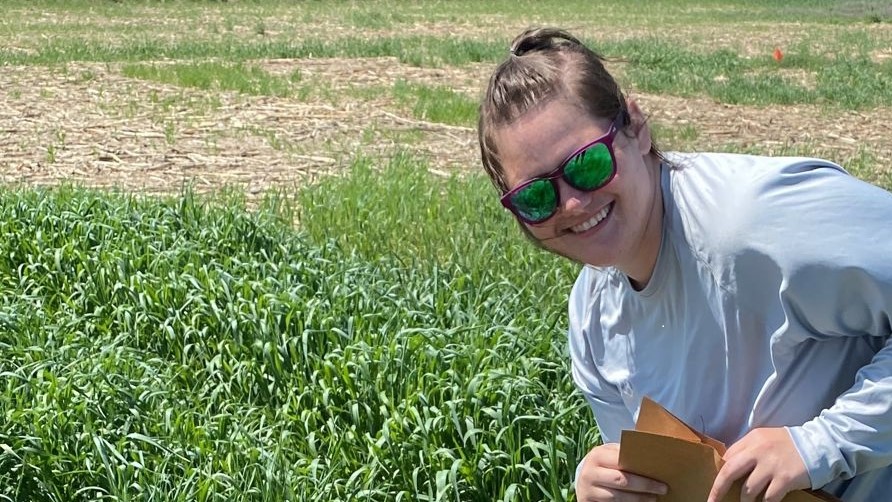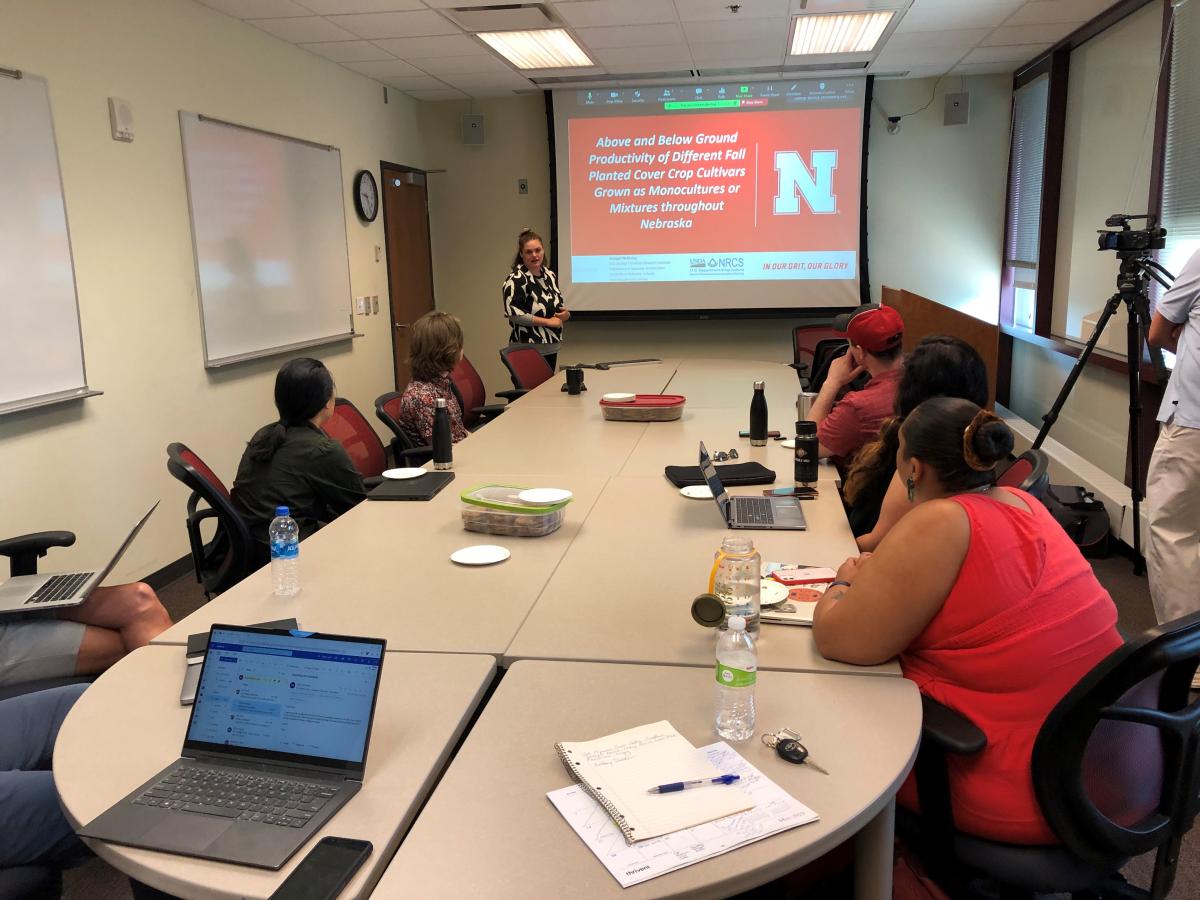Advisor(s): Andrea Basche, Jennifer Keshwani

Comparing cover crops
Farmers may not think about radishes, peas, triticale, collards, camelina, rapeseed or hairy vetch as cover crops, but NRT master’s student Bridget McKinley does.
In a research project with the Natural Resources Conservation Service, McKinley and her advisor, Andrea Basche, are comparing these less traditional cover crops with the more commonly used rye and with oats, barley, wheat and mixes of the crops.
“Research on cover crops and their benefits exists—a lot of it—but there hasn't been any specifically-in-Nebraska side-by-side tests on which cover crops produce best in which regions throughout the state because Nebraska is so diverse throughout,” McKinley says. “So, the goal of the project is to integrate cover crops into systems throughout different ecoregions of Nebraska and see which varieties do best.”
The research team planted the cover crops at three university-owned farms in Concord, North Platte and Scottsbluff in September. They measured the amount of plant growth above ground seven weeks later, in early October, and left crops to grow over the winter. In May, they measured above-ground growth again and measured carbon, nitrogen and below-ground root growth.

With one winter season of field research completed and another left, McKinley has been analyzing her first results. She notes that, so far, rye still appears most successful as a cover crop when measuring the speed and amount of growth above ground.
Farmers typically want to get a cover crop growing as soon as they can after a cash crop to keep roots in the soil and prevent soil from washing away. The crop holds the soil in place over the winter but, in Nebraska, is not typically expected to produce a crop to be harvested. The cover crop may be used as livestock feed or left in the field to decompose, providing nutrients for the next crop planted.
Keeping soil in place with roots may be an important reason to use cover crops, but farmers may also be concerned about levels of nitrogen and carbon in their soil. Plants need nitrogen to grow, but too much nitrogen lost from the soil can harm humans, wildlife, water and air. Similarly, too much carbon in the air is thought to trap heat, contributing to global warming and climate change. McKinley is exploring which cover crops might best alleviate problems with nitrogen and carbon.
“If you have cover crops, they can take carbon out of the air, and then if you're letting them decompose in the field, that carbon is being sequestered into the soil,” she explains.
Legumes put nitrogen into the soil, so McKinley included rye-and-legume mixes in her first planting.
“Mixes that include rye also did very well, like mixtures of rye and hairy vetch, and that’s super interesting because then you're including a legume in that mix,” she says. “That has the potential to have some of the benefits of a legume but also having the ground cover and that root system like what we want with a rye.”
The peas only grew in North Platte, the collards only grew at Concord, and the camelina failed to grow at all. Camelina has been successfully used as a cover crop in other places like Montana, McKinley says, but her team may have planted it too early.
“When you have 30 treatments, you have to pick the best overall date, what's going to work best for most of the varieties, and so we think camelina was planted too early because it should be planted closer to frost,” she says.
Only about 5 percent of Nebraska farmers plant cover crops now, McKinley says. Once she has more information on how well specific cover crops did in the different regions of Nebraska, the Natural Resources Conservation Service can disperse it to the public.

A nontraditional student, McKinley came to Nebraska after growing up in an aviation family in New Jersey, taking college courses in geology and English, working on a small farm in New Mexico through the Worldwide Opportunities on Organic Farms organization, serving as the produce buyer at a grocery store and returning to New Jersey to care for her ailing grandfather. While caring for her grandfather, she realized she could complete a degree at nearby Stockton University in sustainability and agroecology.
“I really enjoyed that experience and kind of fell in love with school again,” she says, “I decided to continue my education and get my master’s after graduating with my undergrad at the ripe old age of 28.”
Having worked in varied facets of the food system, she says she realized she was missing a piece in understanding the food system and that piece was large-scale agriculture. She searched for and found Basche and the cover crop project and received additional support through the National Science Foundation Research Traineeship.
“This is my big introduction to the Midwest cropping system,” she says. “I think the biggest thing I'm learning is how unique each region in Nebraska is and how that influences productivity and biomass production, because it's not the same across all three sites.”
She says most students in her agronomy classes grew up in farming and have that edge in knowledge and understanding but she hopes to take what she has learned in agroecology, the “marriage of agronomy and ecology,” and make it practical for farmers. She points to use of cover crops as one way to do that.
“Introducing ecological principles like cover crops into cropping systems allows the systems to better adapt to major changes like flooding,” she says. “If you have continuous roots in the soil, the reactions to major environmental disturbances is not going to be as extreme as it is without the introduction of cover crops.”
The journey from geology and English to sustainability and agroecology has been long, but McKinley says she thinks she’s on the right path.
“I never was someone who was going to accept doing something that I didn't feel fulfilled doing,” she says. “I think I'm lucky that way, that I was always chasing the passion, something that would fuel me. I knew I wanted to go into a career where I felt passionate and I wanted to be there, and yeah, I think this is it.”
— Ronica Stromberg, NRT Program Coordinator


